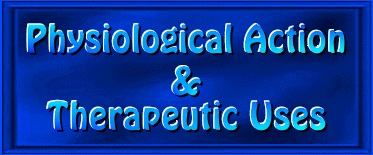

The following is excerpted from The Professional's Herbal Formula Handbook No. 2, comprising 82 pages of traditional information and recent scientific data that describes the medical properties, physiological action and therapeutic uses for each of the 24 ingredients outlined in this formula.




Adaptogenic, alexiteric, anabolic, alterative, antibiotic, anti-cachexic, anti-dyscratic, anti-infective, antineoplastic (anti-tumor), antioxidant, antiphlogistic (anti-inflammatory), antiseptic, bacteriostatic (anti-bacterial), cytophylactic, cytotoxic, decongestant, depurative, detoxicant, disinfectant, diuretic, fungistatic (anti-fungal), immuno-potentiating, immuno-stimulant, microbicidal (anti-microbial), prophylactic, stimulant (circulatory and secretolytic), tonic, vasodilator, vasotonic and viricidal (anti-viral).


Alleviates any general fluids dyscrasia (abnormal or pathological condition) within the blood vessels, tissue-systems and mucous membranes throughout the entire organism during the onset of any immuno-depressant or immuno-suppressant conditions, and eliminates any form of cachexia (state of malnourishment and general debility) within the blood vessels, tissue-systems or mucous membranes throughout the entire organism in order to provide increased protection against any nutritional deficiencies or insufficiency that leads to various forms of immuno-depression or immuno-suppression; stimulates, strengthens and tonifies a deficient immune system, thereby enhancing greater resistance towards any infectious conditions (e.g., recurrent or systemic yeast infections); exhibits immuno-potentiating and immuno-stimulatory effects in order to enhance greater long-term immune potential and overall non-specific systemic immunity (or immune cell activity) and increased immune response (by activating the body's natural defense mechanisms), particularly in relation to the repair and restoration of any damaged or congested blood vessels, tissue-systems or mucous membranes throughout the entire organism; displays prophylactic activity towards the acquired immune deficiency syndrome (AIDS), and encourages the proper elimination of toxic waste materials during the treatment of various auto-immune system disorders; provides significant beneficial effects in the treatment of AIDS, Epstein-Barr virus and other viral infections by inhibiting certain key viral enzymes such as DNA and RNA polymerases and retrovirus reverse transcriptase, due to the presence of beta-lapachone; displays antibiotic and fungistatic properties, due to the presence of alpha-lapachone, beta-lapachone and the quinone xyloidone; displays cytophylactic and cytotoxic properties in order to provide stronger cellular defense mechanisms against many physical or chemical agents and infectious conditions, including various brain, skin or intestinal infections; exhibits bacteriostatic, microbicidal and viricidal activity in order to strengthen and increase the resistance of the blood vessels against any invasive or harmful pathogenic bacteria or microbes, as well as to inhibit the further development of any inflammatory or infectious conditions associated with the onset of various auto-immune disorders; demonstrates powerful microbicidal and fungistatic activity against Candida albicans and Tricophyton mentagrophytes, due to the presence of naphthoquinones, anthraquinones, lapachenole, the flavonoid quercetin, and o- and p-hydroxy benzoic acids; exhibits significant microbicidal effects against Gram-positive or acid-fast bacteria and fungi, while uncoupling any oxidative phosphorylation (due to the presence of lapachol); inhibits the causative agents associated with tuberculosis, dysentery and anthrax (due to the presence of the quinone xyloidone), as well as several species of fungi (including Candida albicans, C. kruzei and C. neoformans); possesses cytophylactic and cytotoxic effects against certain parasites (due to the presence of the flavonoid quercetin), and interferes with the energy-production and enzymatic reactions associated with various microorganisms (due to the presence of the naphthoquinone lapachol); displays significant viricidal activity against a number of viruses, due to the presence of certain naphthoquinones such as lapachol (or lapachic acid or tecomin), beta-lapachone and hydroxynaphthoquinone; exhibits significant antiphlogistic activity in order to inhibit the formation of certain inflammatory compounds (such as histamine, leukotrienes, prostaglandin, serine proteases and thromboxanes), as well as to reduce any severe inflammatory swelling associated with any blood vessel or tissue inflammation and various other internal inflammatory conditions; demonstrates powerful antiphlogistic effects (with low toxicity) against a wide range of inflammatory conditions, such as cervicitis and cervicovaginitis; exhibits significant antiseptic activity by destroying the vitality of any organized living ferments in order to prevent the onset of putrefaction or septicemia, and precipitates the proteins in any inflamed tissues in order to provide a mildly antiseptic and protective coating (under which the regeneration of new tissue occurs) for the mucous membranes throughout the entire organism; acts as an effective antiseptic in order to remove any septic conditions associated with tissue degeneration or ulceration, and promotes increased suppuration and a steady toning or restorative impression to the entire glandular system (especially the liver and lymph glands); exhibits significant antineoplastic (anti-tumor) activity against various cancerous disorders, including Hodgkin's disease, leukemia (the sodium salt of lapachol is active against L210 leukemia), adenocarcinoma of the pancreas, and cancer of the esophagus, head, intestines, lungs, prostate and tongue; exhibits anabolic activity in order to accelerate the production of DNA and RNA (which enhances the production of proteins in the form of antibodies), while increasing protein and lipid synthesis in the bone marrow and DNA/RNA content in the adrenals and lymph nodes (along with increased body weight and enhanced re-synthesis of glycogen and high-energy phosphate compounds); demonstrates powerful adaptogenic (balancing and strengthening) activity in order to increase the overall resistance of an organism towards any adverse influences or stressful conditions (whether they be physical, chemical or biological in nature), especially upon the immune system and both the central (cerebro-spinal centers) and peripheral nervous systems; acts as a secretolytic stimulant in order to promote increased gastric, pancreatic or intestinal secretory and motor activity, and enhances greater peripheral circulation (due to its antioxidant activity); exhibits significant antioxidant effects in order to provide greater oxygen-transport capabilities throughout the bloodstream, as well as enhance the transport of additional oxygen directly into the cells and tissue-systems throughout the entire organism; acts as a circulatory stimulant by increasing the blood flows through the arteries and blood vessels in order to enhance greater nutrient transport, absorption and utilization, thereby accelerating the healing processes associated with the repair of any damaged mucous membranes or tissue-systems; activates the bodily processes of detoxification and elimination in order to cleanse and purify the bloodstream and tissue-systems, and increases the secretion and elimination of urine in order to provide further support to the inner cleansing process; displays alterative activity in order to correct any disordered bodily function, thereby activating increased alterations in both metabolic and tissue functions as a defensive measure against the onset of acute or chronic disease; exhibits restorative effects in order to regain increased vigor or vitality and greater strength, while enhancing normal tissue and metabolic functional capabilities; demonstrates alterative and restorative properties in order to re-establish healthy systemic functional capabilities, as well as to establish greater vascular tone throughout the entire organism (due to its ability to stimulate increased secretory flows); exhibits alterative effects in order to stimulate the anabolic growth processes, thereby enhancing the repair of any degenerated, deteriorated or debilitated cells or tissues (while promoting the elimination of any catabolic waste materials); displays tonifying effects in order to permanently enhance the overall energy-levels throughout the entire organism, without adversely affecting the functional capabilities of any particular organ or system.
![]()
None.
![]()